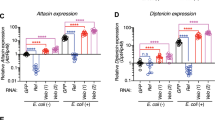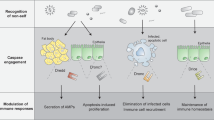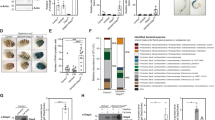Abstract
The innate immune system represents an ancient host defence mechanism that protects against invading microorganisms. An important class of immune effector molecules to fight pathogen infections are antimicrobial peptides (AMPs) that are produced in plants and animals1. In Drosophila, the induction of AMPs in response to infection is regulated through the activation of the evolutionarily conserved Toll and immune deficiency (IMD) pathways2. Here we show that AMP activation can be achieved independently of these immunoregulatory pathways by the transcription factor FOXO, a key regulator of stress resistance, metabolism and ageing. In non-infected animals, AMP genes are activated in response to nuclear FOXO activity when induced by starvation, using insulin signalling mutants, or by applying small molecule inhibitors. AMP induction is lost in foxo null mutants but enhanced when FOXO is overexpressed. Expression of AMP genes in response to FOXO activity can also be triggered in animals unable to respond to immune challenges due to defects in both the Toll and IMD pathways. Molecular experiments at the Drosomycin promoter indicate that FOXO directly binds to its regulatory region, thereby inducing its transcription. In vivo studies in Drosophila, but also studies in human lung, gut, kidney and skin cells indicate that a FOXO-dependent regulation of AMPs is evolutionarily conserved. Our results indicate a new mechanism of cross-regulation of metabolism and innate immunity by which AMP genes can be activated under normal physiological conditions in response to the oscillating energy status of cells and tissues. This regulation seems to be independent of the pathogen-responsive innate immunity pathways whose activation is often associated with tissue damage and repair. The sparse production of AMPs in epithelial tissues in response to FOXO may help modulating the defence reaction without harming the host tissues, in particular when animals are suffering from energy shortage or stress.
This is a preview of subscription content, access via your institution
Access options
Subscribe to this journal
Receive 51 print issues and online access
$199.00 per year
only $3.90 per issue
Buy this article
- Purchase on Springer Link
- Instant access to full article PDF
Prices may be subject to local taxes which are calculated during checkout



Similar content being viewed by others
References
Bulet, P., Stöcklin, R. & Menin, L. Anti-microbial peptides: from invertebrates to vertebrates. Immunol. Rev. 198, 169–184 (2004)
Lemaitre, B. & Hoffmann, J. The host defense of Drosophila melanogaster . Annu. Rev. Immunol. 25, 697–743 (2007)
Uvell, H. & Engström, Y. A multilayered defense against infection: combinatorial control of insect immune genes. Trends Genet. 23, 342–349 (2007)
Hoffmann, J. A. & Reichhart, J. M. Drosophila innate immunity: an evolutionary perspective. Nature Immunol. 3, 121–126 (2002)
Tzou, P. et al. Tissue-specific inducible expression of antimicrobial peptide genes in Drosophila surface epithelia. Immunity 13, 737–748 (2000)
Selsted, M. E. & Ouellette, A. J. Mammalian defensins in the antimicrobial immune response. Nature Immunol. 6, 551–557 (2005)
Zasloff, M. Defending the epithelium. Nature Med. 12, 607–608 (2006)
Fuss, B., Becker, T., Zinke, I. & Hoch, M. The cytohesin Steppke is essential for insulin signalling in Drosophila . Nature 444, 945–948 (2006)
Hafner, M. et al. Inhibition of cytohesins by SecinH3 leads to hepatic insulin resistance. Nature 444, 941–944 (2006)
Böhni, R. et al. Autonomous control of cell and organ size by CHICO, a Drosophila homolog of vertebrate IRS1–4. Cell 97, 865–875 (1999)
Flatt, T. et al. Hormonal regulation of the humoral innate immune response in Drosophila melanogaster . J. Exp. Biol. 211, 2712–2724 (2008)
Britton, J. S., Lockwood, W. K., Li, L., Cohen, S. M. & Edgar, B. A. Drosophila’s insulin/PI3-kinase pathway coordinates cellular metabolism with nutritional conditions. Dev. Cell 2, 239–249 (2002)
Wu, J., Randle, K. E. & Wu, L. P. ird1 is a Vps15 homologue important for antibacterial immune responses in Drosophila . Cell. Microbiol. 9, 1073–1085 (2007)
Bauer, M. et al. Purine and folate metabolism as a potential target of sex-specific nutrient allocation in Drosophila and its implication for lifespan-reproduction tradeoff. Physiol. Genomics 25, 393–404 (2006)
Hafen, E. Cancer, type 2 diabetes, and ageing: news from flies and worms. Swiss Med. Wkly. 134, 711–719 (2004)
Puig, O., Marr, M. T., Ruhf, M. L. & Tjian, R. Control of cell number by Drosophila FOXO: downstream and feedback regulation of the insulin receptor pathway. Genes Dev. 17, 2006–2020 (2003)
Min, K. J., Yamamoto, R., Buch, S., Pankratz, M. & Tatar, M. Drosophila lifespan control by dietary restriction independent of insulin-like signaling. Aging Cell 7, 199–206 (2008)
Zinke, I., Schutz, C. S., Katzenberger, J. D., Bauer, M. & Pankratz, M. J. Nutrient control of gene expression in Drosophila: microarray analysis of starvation and sugar-dependent response. EMBO J. 21, 6162–6173 (2002)
Hwangbo, D. S., Gersham, B., Tu, M., Palmer, M. & Tatar, M. Drosophila dFOXO controls lifespan and regulates insulin signalling in brain and fat body. Nature 429, 562–566 (2004)
Furuyama, T., Nakazawa, T., Nakano, I. & Mori, N. Identification of the differential distribution patterns of mRNAs and consensus binding sequences for mouse DAF-16 homologues. Biochem. J. 349, 629–634 (2000)
Ferrandon, D. et al. A drosomycin–GFP reporter transgene reveals a local immune response in Drosophila that is not dependent on the Toll pathway. EMBO J. 17, 1217–1227 (1998)
De Gregorio, E., Spellman, P. T., Tzou, P., Rubin, G. M. & Lemaitre, B. The Toll and Imd pathways are the major regulators of the immune response in Drosophila . EMBO J. 21, 2568–2579 (2002)
Dionne, M. S., Pham, L. N., Shirasu-Hiza, M. & Schneider, D. S. Akt and foxo dysregulation contribute to infection-induced wasting in Drosophila . Curr. Biol. 16, 1977–1985 (2006)
Simon, A. et al. Drosomycin-like defensin, a human homologue of Drosophila melanogaster drosomycin with antifungal activity. Antimicrob. Agents Chemother. 52, 1407–1412 (2008)
Bischoff, V. et al. Downregulation of the Drosophila immune response by peptidoglycan-recognition proteins SC1 and SC2. PLoS Pathog. 2, e14 (2006)
Zaidman-Rémy, A. et al. The Drosophila amidase PGRP-LB modulates the immune response to bacterial infection. Immunity 24, 463–473 (2006)
Ryu, J. H. et al. Innate immune homeostasis by the homeobox gene caudal and commensal-gut mutualism in Drosophila . Science 319, 777–782 (2008)
Libert, S., Chao, Y., Zwiener, J. & Pletcher, S. D. Realized immune response is enhanced in long-lived puc and chico mutants but is unaffected by dietary restriction. Mol. Immunol. 45, 810–817 (2008)
Garsin, D. A. et al. Long-lived C. elegans daf-2 mutants are resistant to bacterial pathogens. Science 300, 1921 (2003)
Evans, E. A., Chen, W. C. & Tan, M. W. The DAF-2 insulin-like signaling pathway independently regulates aging and immunity in C. elegans . Aging Cell 7, 879–893 (2008)
Acknowledgements
For sending flies and constructs, we thank M. Tatar (foxo21, foxoW24 and UAS foxoTM), B. Lemaitre (RelishE20, spätzleRM7), S. Cohen (UAS foxo–GFP) and M. Boutros (luciferase vectors). Thanks to M. Famulok for providing the Steppke inhibitor SecinH3. N. Novak, J. Grell and A. Schmitz assisted with luciferase assays. We thank S. Mario-Wegner for help with transgenic luciferase flies. We thank members of the Famulok, Schultze and Hoch laboratory for discussions. This work was supported by grants from the DFG to M.H. (SFBs 645 and 704).
Author Contributions T.B. did AMP expression studies in Drosophila, promoter analysis, reporter gene expression studies, luciferase assays in larvae and tissue-dependent AMP expression. P.C. performed in situ hybridization experiments and clonal analysis. I.Z. cloned the wild-type and deletion luciferase constructs and made transgenic flies. G.L., T.B. and A.C.A. made the mutated luciferase constructs. I.Z. and G.L. performed luciferase assays in cell culture. M.B. did EMSA band shift assays. A.C.A. and T.I. analysed Drs-like defensin and defensin expression in mammalian cell lines. M.H. supervised the research project and experimental design, M.H. and J.L.S. jointly supervised the work in mammalian cell lines. All authors discussed the experimental results. T.B. and M.H. wrote the manuscript.
Author information
Authors and Affiliations
Corresponding author
Ethics declarations
Competing interests
The authors declare no competing financial interests.
Supplementary information
Supplementary Information
This file contains Supplementary Methods and Data, Supplementary Table ST1 and Supplementary Figures S1-S16 with Legends. (PDF 3259 kb)
Rights and permissions
About this article
Cite this article
Becker, T., Loch, G., Beyer, M. et al. FOXO-dependent regulation of innate immune homeostasis. Nature 463, 369–373 (2010). https://doi.org/10.1038/nature08698
Received:
Accepted:
Issue Date:
DOI: https://doi.org/10.1038/nature08698
This article is cited by
-
Gut barrier defects, intestinal immune hyperactivation and enhanced lipid catabolism drive lethality in NGLY1-deficient Drosophila
Nature Communications (2023)
-
Proteomic basis of mortality resilience mediated by FOXO3 longevity genotype
GeroScience (2023)
-
Skin microbiota analysis in patients with anorexia nervosa and healthy-weight controls reveals microbial indicators of healthy weight and associations with the antimicrobial peptide psoriasin
Scientific Reports (2022)
-
Functional conservation in genes and pathways linking ageing and immunity
Immunity & Ageing (2021)
-
Mild thermal stress does not negatively affect immune gene expression in the bumblebee Bombus terrestris
Apidologie (2021)
Comments
By submitting a comment you agree to abide by our Terms and Community Guidelines. If you find something abusive or that does not comply with our terms or guidelines please flag it as inappropriate.



